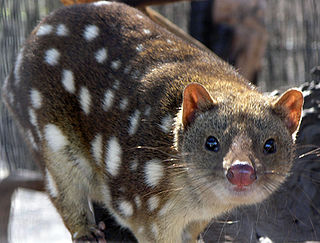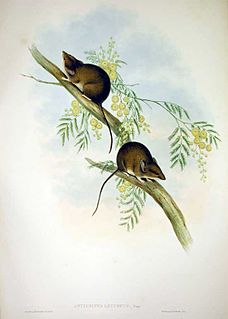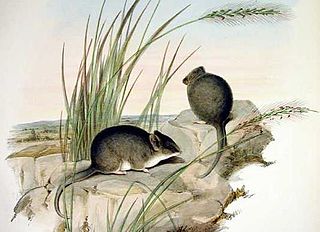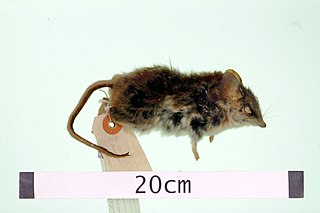
The Dasyuridae are a family of marsupials native to Australia and New Guinea, including 69 extant species divided into 21 genera. Many are small and mouse-like or shrew-like, giving some of them the name marsupial mice or marsupial shrews, but the group also includes the cat-sized quolls, as well as the Tasmanian devil. They are found in a wide range of habitats, including grassland, underground, forests, and mountains, and some species are arboreal or semiaquatic. The Dasyuridae are often called the 'marsupial carnivores', as most members of the family are insectivores.

Dunnart is a common name for species of the genus Sminthopsis, narrow-footed marsupials the size of a European mouse. They have a largely insectivorous diet.

The subfamily Sminthopsinae includes several genera of small, carnivorous marsupials native to Australia: kultarrs, ningauis, dunnarts, and planigales.

Smintopsini is a tribe of marsupial in the family Dasyuridae.

The fat-tailed dunnart is a species of mouse-like marsupial of the Dasyuridae, the family that includes the little red kaluta, quolls, and the Tasmanian devil. It has an average body length of 60–90 millimeters (2.4–3.5 in) with a tail of 45–70 millimeters (1.8–2.8 in). Ear length is 14–16 millimeters (0.55–0.63 in). One of the smallest carnivorous marsupials, its weight varies between 10–20 grams (0.35–0.71 oz). The tail becomes fat a few mm from the proximal end and remains so right up to the tip. The dunnart has trichromat vision, similar to some other marsupials as well as primates but unlike most mammals which have dichromat vision. The dunnart is often eaten by other carnivores, including invasive foxes and cats, as well as other feral animals that live among its environment.

The slender-tailed dunnart, also known as the common dunnart in Australia, is a dasyurid marsupial. It has an average body length of 7 to 12 centimeters (2.8–4.7 in) with a tail length of 5.5 to 13 centimetres (2.2–5.1 in). It weighs 25–40.8 grams for males and 16.5–25.4 grams for females.

The chestnut dunnart is a dunnart that was described by Van Dyck in 1986 and is named because of its chestnut colour in the upperparts of its body. The length from snout to tail is 167–210 mm, of which head to anus is 85–105 mm and tail is 82–105 mm long. The hind foot size is 17–20 mm, ear length is 17–21 mm and weight is 15–20 g.

The long-tailed dunnart is an Australian dunnart that, like the little long-tailed dunnart, has a tail longer than its body. It is also one of the larger dunnarts at a length from snout to tail of 260–306 mm of which head to anus is 80–96 mm and tail 180–210 mm long. Hind foot size is 18 mm, ear length of 21 mm and with a weight of 15-20 g.

The striped-faced dunnart is a small, Australian, nocturnal, "marsupial mouse," part of the family Dasyuridae. The species' distribution occurs throughout much of inland central and northern Australia, occupying a range of arid and semi-arid habitats.

The white-tailed dunnart, also known as the ash-grey dunnart, is a dunnart native to Australia.

The red-cheeked dunnart is so called because of the distinctive red hair on its cheek. It is an Australasian marsupial. Its total length is 167–270 mm; its average body length is 80–135 mm with a tail of 87–135 mm. Ear length is 12–13 mm. Its weight varies between 18 and 75 grams. Its tail is thin and pale pink.

The Julia Creek dunnart is a marsupial with a buffy brown upperside and white underside. This dunnart has a body length of 100–135 mm with a tail of 60–105 mm to make a total length of 160–240 mm. Its weight is between 40 and 70 g. The length of the hind foot is 22–24 mm. The species has a dark brown triangle colour from above and below the eye with the point at the nose, and another dark stripe on top of the skull. A healthy dunnart has a carrot-shaped tail filled with fat stores.

The hairy-footed dunnart is a dunnart that has silver hairs on the soles of it hind feet accompanied by long hair on the side of its sole. It is an Australian marsupial similar to the Ooldea dunnart, with its upper body yellow-brown and lower body white in colour. Its total length is 147–180 mm; its average body length is 72–85 mm with a tail of 75–95 mm. Its ear length is 15 mm. This dasyurid weighs between 13 and 19 grams. Its tail is thin and pinkish white, can be thickened at the base.

The Ooldea dunnart, also called Troughton's dunnart after the person who found the species, is an Australian marsupial similar to the hairy-footed dunnart. It is greyish-yellow on its upper body and white on the underside with dark patches on its crown, forehead and in front of the eyes, and a pink thinly furred carrot shaped tail. Its total length is 115–173 mm; its average body length is 55–80 mm with a tail of 60–93 mm. Its ear length is 14–17 mm. This dunnart weighs between 10 and 18 grams.

Ningaui is a genus of small species of the marsupial dasyurid family. Along with the planigales, they are among the smallest marsupials.

The sandhill dunnart is a species of small carnivorous Australian marsupial of the family Dasyuridae. It is known from four scattered arid areas of Australia: near Lake Amadeus in Northern Territory, the central Eyre Peninsula in South Australia, the southwestern edge of the Great Victoria Desert in Western Australia, and at Yellabinna in South Australia.

The crest-tailed mulgara, is a small to medium-sized Australian carnivorous marsupial and a member of the family Dasyuridae which includes quolls, dunnarts, the numbat, Tasmanian devil and extinct thylacine. The crest-tailed mulgara is among a group of native predatory mammals or mesopredators endemic to arid Australia.

















